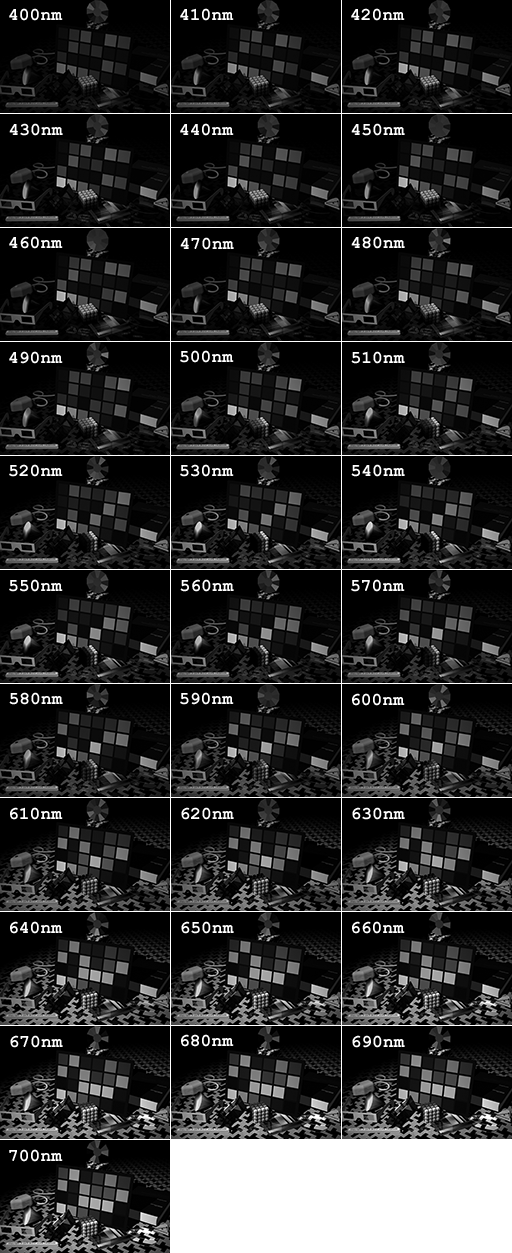
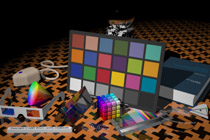 In the interest of digital imaging research, I am providing a set of four images that represent "perfect" images,
that is, they represent a natural scene (as opposed to say, a test pattern or a gradient) which is completely
void of any noise, aliasing or other image artifacts. They were taken with a virtual, six mega-pixel camera
using a ray tracing program I wrote myself. The intensity of each pixel was computed in double precision
floating point and then companded and quantized to 8- or 16-bits per channel at the last possible moment before
writing the image file. The four variations represent all combinations of 8- or 16-bits per channel and gamma
of 1.0 or 2.2. I believe these images will be useful for research purposes in answering such questions as
"How many bits are needed to avoid visual defects?" and "How does one determine the number of bits of real
image information, as opposed to digitized noise?" In this sense, they may provide ideal image references
against which actual digitized images may be compared by various visual or statistical analysis techniques.
In the interest of digital imaging research, I am providing a set of four images that represent "perfect" images,
that is, they represent a natural scene (as opposed to say, a test pattern or a gradient) which is completely
void of any noise, aliasing or other image artifacts. They were taken with a virtual, six mega-pixel camera
using a ray tracing program I wrote myself. The intensity of each pixel was computed in double precision
floating point and then companded and quantized to 8- or 16-bits per channel at the last possible moment before
writing the image file. The four variations represent all combinations of 8- or 16-bits per channel and gamma
of 1.0 or 2.2. I believe these images will be useful for research purposes in answering such questions as
"How many bits are needed to avoid visual defects?" and "How does one determine the number of bits of real
image information, as opposed to digitized noise?" In this sense, they may provide ideal image references
against which actual digitized images may be compared by various visual or statistical analysis techniques.
The scene is titled Delta E and represents an imaginary view of my imaginary desktop (I am a color scientist).
I offer these images for research and other non-commercial purposes. In consideration of the time and effort put forth in their preparation, I request that my copyright notice accompany them wherever they are used.
All four images are RGB color type and in TIFF format. All have dimensions 3072 × 2048 = 6,291,456 pixels. All images are tagged with ICC reference profiles (sRGB primaries and white point). Other relevant information is shown in the following table:
| Image File | Download Size (Mb) | Bits Per Channel |
Gamma | Number of Levels | Number of Unique Colors |
|||
|---|---|---|---|---|---|---|---|---|
| SIT | ZIP | Red | Green | Blue | ||||
| DeltaE_16bit_gamma1.0.tif | 8.6 | 12.0 | 16 | 1.0 | 50,731 | 49,518 | 52,092 | 1,045,769 |
| DeltaE_16bit_gamma2.2.tif | 11.1 | 15.9 | 16 | 2.2 | 59,027 | 58,235 | 60,150 | 1,260,832 |
| DeltaE_8bit_gamma1.0.tif | 0.9 | 1.4 | 8 | 1.0 | 241 | 247 | 249 | 89,029 |
| DeltaE_8bit_gamma2.2.tif | 1.2 | 1.7 | 8 | 2.2 | 250 | 253 | 253 | 134,683 |
Notes:
In commemoration of the ten-year anniversary of the RGB Reference Images, I have prepared a set of images that are ray-traced spectrally. Therefore, for each pixel, we have 31 samples rather than just three. The samples are taken from 400 to 700 nm, in 10 nm increments. The samples are stored in 31, 16-bit grayscale TIFF files. Each sample represents the reflectance, relative to the CIE Reference Illuminant E. The 31 files are available upon special request (ZIP format, 113 Mb).
Here is a thumbnail view of the files:

These images may be rendered to RGB by constructing, for each pixel, a spectral sample by sampling all 31 images at each pixel location. The spectrum may be converted to XYZ by multiplying it by your choice of illuminant and your choice of CIE Standard Observer functions. XYZ may be further converted to other forms, such as RGB. The necessary equations are found in the Math section of my site. You will need to write your own custom software to do this. There is no way to do it in any commercial package like Photoshop.
Here are a couple example renderings:
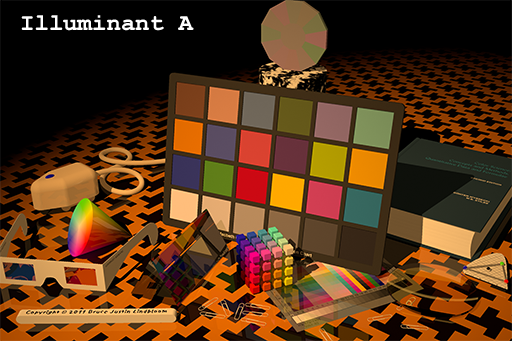
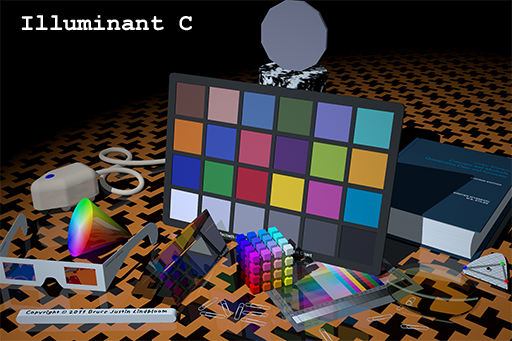
One change to the 3D model was made. The mirrored ball (above the ColorChecker chart) has been replaced by a metamerism example. This object is made up of a central shape (having a flat spectrum), surrounded by 12 slices that are metamers to the center color when viewed under CIE Reference Illuminant C. The spectra for these slices are taken from Table III(3.8.2) of Wyszecki and Stiles' Color Science book. Here is a graph showing these metamers:
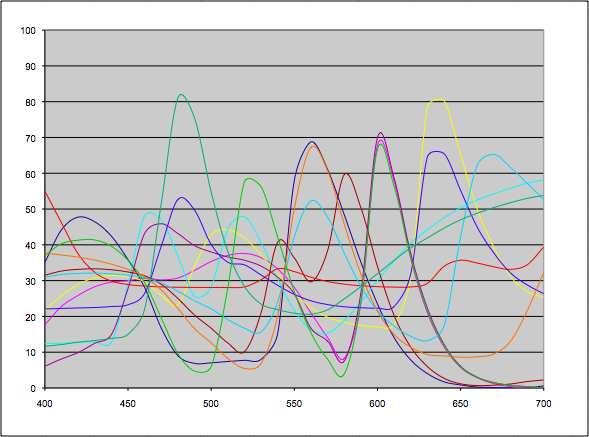
When rendered under the qualifying conditions, the 13 sections all match, even though their spectra are radically different. Here is a detailed view of the metamer model:
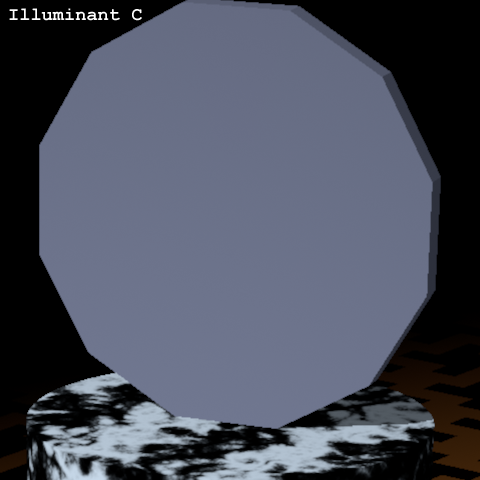
When rendered under a different illuminant, these sections no longer match. Here is an example rendered under CIE Reference Illuminant A:
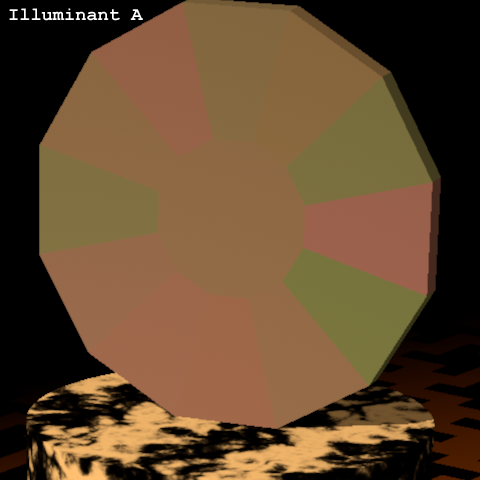
The swatches of the ColorChecker chart use the same spectral reflectances shown in the ColorChecker Calculator.